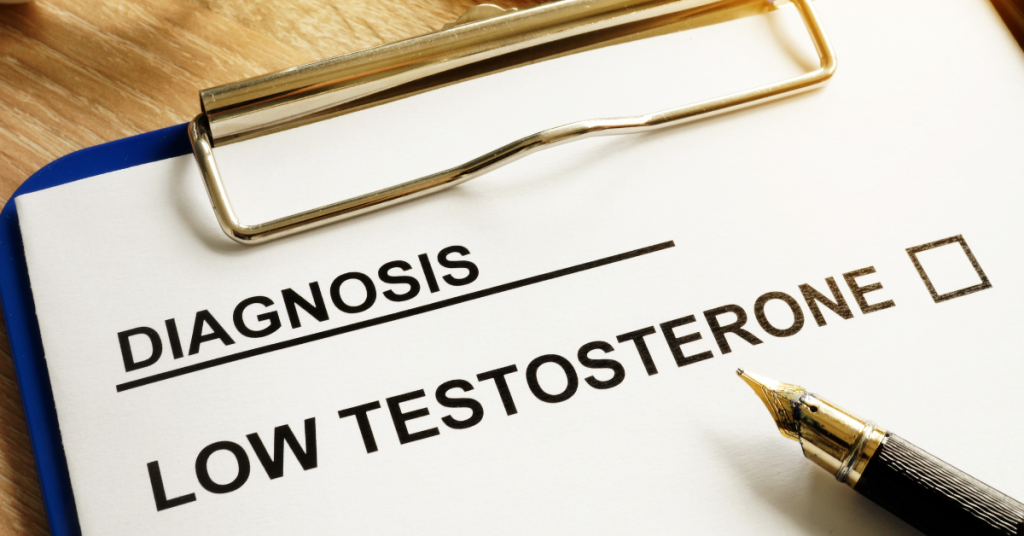Negative connotations linked with testosterone—such as aggressive behavior and unnaturally large muscles—often stem from confusing the abuse of anabolic steroids with medically supervised testosterone replacement therapy (TRT). Men diagnosed with low testosterone, or low T, who are trying to lose weight and gain muscle mass may even avoid TRT because of misconceptions about testosterone treatments.
What Is Testosterone Replacement Therapy?
Want to understand the difference between TRT and performance-enhancing steroids? It’s best to start by learning the role testosterone plays and why some men who develop low testosterone levels decide to treat it with testosterone replacement therapy.
Most people know that testosterone is the primary male sex hormone influencing a man’s masculinity and sex drive. But it also plays a role in many other characteristics, including:
- Bone density
- Fat distribution
- Muscle mass
- Muscle strength
- Facial and body hair
- Sexual performance
- Sperm production

Testosterone production peaks in adolescence and early adulthood before gradually declining throughout the rest of your life. Lower testosterone levels are associated with signs of aging, but for some men, the level of testosterone dips more significantly and impacts the quality of their lives. Low T symptoms include loss of muscle mass, reduced physical performance, low libido, mood swings, fatigue, and an inability to concentrate.
Hormone specialists carefully monitor testosterone replacement therapy, customizing the dosage for each patient based on blood tests taken before beginning TRT.
What Are Steroids?
Even though many people view steroids with skepticism, they are simply microscopic molecules with a specific structure made of 4 fused rings and various side chains. Performance-enhancing anabolic steroids—which is the type most people think of when discussing steroids—are synthetic (man-made) versions of testosterone. Another type of steroid, called a corticosteroid—is a very effective treatment for a range of health conditions.
Steroid abuse involves the illegal use of anabolic steroids, typically by individuals who want to increase muscle mass or enhance athletic performance. The word anabolic means “building up.” Anabolic-androgenic steroids often also include other chemicals that aim to enhance physical performance or appearance. For example, many illegal steroids contain growth hormones and even insulin.
What’s the Difference Between Testosterone Replacement Therapy and Steroids?
In some cases, testosterone replacement therapy and illegal steroids have identical ingredients. What differentiates the treatments is the dosage used and the medical supervision involved in TRT. Steroid abusers generally take much higher doses in order to achieve a certain physique and enhance physical performance. Most steroid abusers are weightlifters and bodybuilders in their 20s and 30s. Additionally, some competitive athletes use steroids as performance-enhancing drugs. Unfortunately, this abusive use of anabolic-androgenic steroids has tainted the legitimate use of testosterone replacement therapy. Most of us have heard, for example, that “roid rage” can be a sign that someone is abusing steroids. TRT, on the other hand, is a legal, prescribed treatment for conditions like low testosterone.

Lower Doses with Testosterone Replacement Therapy
As mentioned earlier, the main difference between steroid abuse and testosterone injections is the dosage. Testosterone replacement therapy uses smaller doses to balance your hormone levels so they’re in healthy ranges. This generally means using the smallest dose needed to increase testosterone levels in your bloodstream.
The doses used by steroid users are typically much higher than what doctors recommend. In fact, doses can be anywhere between 10 to 100 times higher than the maximum dosage a doctor would prescribe. This can increase testosterone and other hormone levels beyond the natural limit and put your health at risk.
Side Effects of TRT Compared to Steroids
Different doses and, in some cases, differences in the chemical composition of TRT and steroids mean the potential side effects are not the same.
TRT Effects
Testosterone replacement therapy is generally safe for most men with hypogonadism (low T). Testosterone replacement therapy is an approved method for treating low T without the risk of addiction. At Rejuvime Medical, our team of hormone specialists, including a medical doctor, reviews your medical history and overall health and thoroughly discusses the benefits and risks of TRT before you decide if the treatment is right for you. We also monitor the dosage and any side effects to ensure your safety.
Steroid Abuse Side Effects
The list of potential side effects for steroid abusers, on the other hand, is long and dangerous. Without medical oversight, high doses of steroids can cause:
- Acne
- Aggressive attitude
- Baldness
- Breast development
- Cardiovascular issues
- Lowered sperm count
- Organ damage
- Testicular shrinkage
In addition, some steroid users develop more serious psychological issues, such as paranoid jealousy, delusions, mania, and impaired judgment. In the longer term, abusing steroids can damage organs.
Are You Concerned About Low Testosterone Levels?
If you’ve experienced any of the low T symptoms mentioned in this blog post, such as fatigue, low energy, reduced sex drive, or brain fog, testosterone replacement therapy may offer a solution. You can learn more about hormone therapy by requesting a consultation at either our Baton Rouge or Metairie location using the online form. Or call us at (225) 960-1580 (Baton Rouge) or (504) 252-9579 (Metairie).


Your article’s exploration of whether Testosterone Replacement Therapy (TRT) is the same as steroids is a critical inquiry, as it clarifies a common misconception and highlights the importance of understanding the distinctions.
At first glance, the use of testosterone in TRT and the use of anabolic steroids might appear similar, as both involve testosterone supplementation. However, your article appropriately underscores the fundamental differences in intent, dosage, and medical supervision.
TRT is a medically supervised treatment aimed at restoring testosterone levels within a normal and healthy range in individuals with clinically diagnosed low testosterone. It’s intended to address hormonal imbalances and alleviate symptoms associated with low testosterone, such as fatigue and reduced muscle mass.
Steroid abuse, on the other hand, typically involves the misuse of supraphysiological doses of anabolic steroids for purposes unrelated to medical treatment. This can lead to a range of negative health consequences, including hormonal imbalances, cardiovascular issues, and psychological effects.
By distinguishing between TRT and steroid abuse, your article dispels common misconceptions and encourages a more informed discourse on the subject. It’s essential for individuals to understand that, when used as prescribed by a medical professional, TRT is a legitimate medical treatment with potential health benefits.